Business and System Analysis: XYZ Pharmacy Design Architecture Report
VerifiedAdded on 2019/10/30
|11
|2367
|234
Report
AI Summary
This report presents a comprehensive analysis of the XYZ Pharmacy's business and system design, focusing on both high-level and low-level architectures. The high-level design outlines the pharmacy's IT infrastructure, detailing key components such as sales terminals, customer service, corporate data centers, strategic information, employees, merchandising, supply chain management, and payment processing. The low-level design delves into the specifics of data structures, algorithms, and user interfaces, providing detailed representations of the pharmacy's operational processes, including sale terminals, employee management, payment processing, merchandising, supply chain logistics, and corporate data center functions. The report also includes detailed user interface designs for various system functions such as administration, supplier sessions, and patient sessions. References to relevant literature are also provided.

Running Head: Business and System Analysis
Business and System Analysis
Name
Institutional affiliation
Business and System Analysis
Name
Institutional affiliation
Paraphrase This Document
Need a fresh take? Get an instant paraphrase of this document with our AI Paraphraser
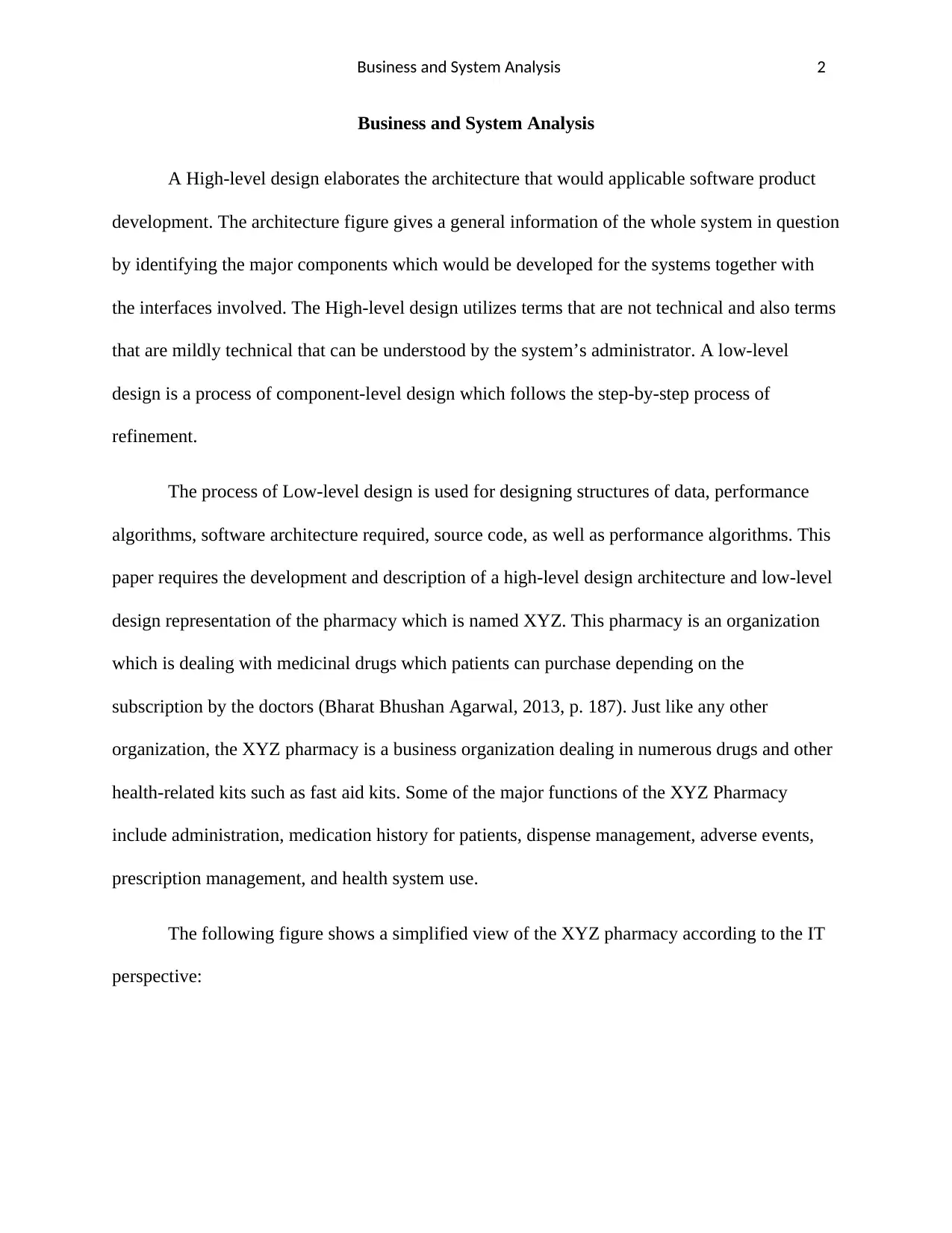
Business and System Analysis 2
Business and System Analysis
A High-level design elaborates the architecture that would applicable software product
development. The architecture figure gives a general information of the whole system in question
by identifying the major components which would be developed for the systems together with
the interfaces involved. The High-level design utilizes terms that are not technical and also terms
that are mildly technical that can be understood by the system’s administrator. A low-level
design is a process of component-level design which follows the step-by-step process of
refinement.
The process of Low-level design is used for designing structures of data, performance
algorithms, software architecture required, source code, as well as performance algorithms. This
paper requires the development and description of a high-level design architecture and low-level
design representation of the pharmacy which is named XYZ. This pharmacy is an organization
which is dealing with medicinal drugs which patients can purchase depending on the
subscription by the doctors (Bharat Bhushan Agarwal, 2013, p. 187). Just like any other
organization, the XYZ pharmacy is a business organization dealing in numerous drugs and other
health-related kits such as fast aid kits. Some of the major functions of the XYZ Pharmacy
include administration, medication history for patients, dispense management, adverse events,
prescription management, and health system use.
The following figure shows a simplified view of the XYZ pharmacy according to the IT
perspective:
Business and System Analysis
A High-level design elaborates the architecture that would applicable software product
development. The architecture figure gives a general information of the whole system in question
by identifying the major components which would be developed for the systems together with
the interfaces involved. The High-level design utilizes terms that are not technical and also terms
that are mildly technical that can be understood by the system’s administrator. A low-level
design is a process of component-level design which follows the step-by-step process of
refinement.
The process of Low-level design is used for designing structures of data, performance
algorithms, software architecture required, source code, as well as performance algorithms. This
paper requires the development and description of a high-level design architecture and low-level
design representation of the pharmacy which is named XYZ. This pharmacy is an organization
which is dealing with medicinal drugs which patients can purchase depending on the
subscription by the doctors (Bharat Bhushan Agarwal, 2013, p. 187). Just like any other
organization, the XYZ pharmacy is a business organization dealing in numerous drugs and other
health-related kits such as fast aid kits. Some of the major functions of the XYZ Pharmacy
include administration, medication history for patients, dispense management, adverse events,
prescription management, and health system use.
The following figure shows a simplified view of the XYZ pharmacy according to the IT
perspective:
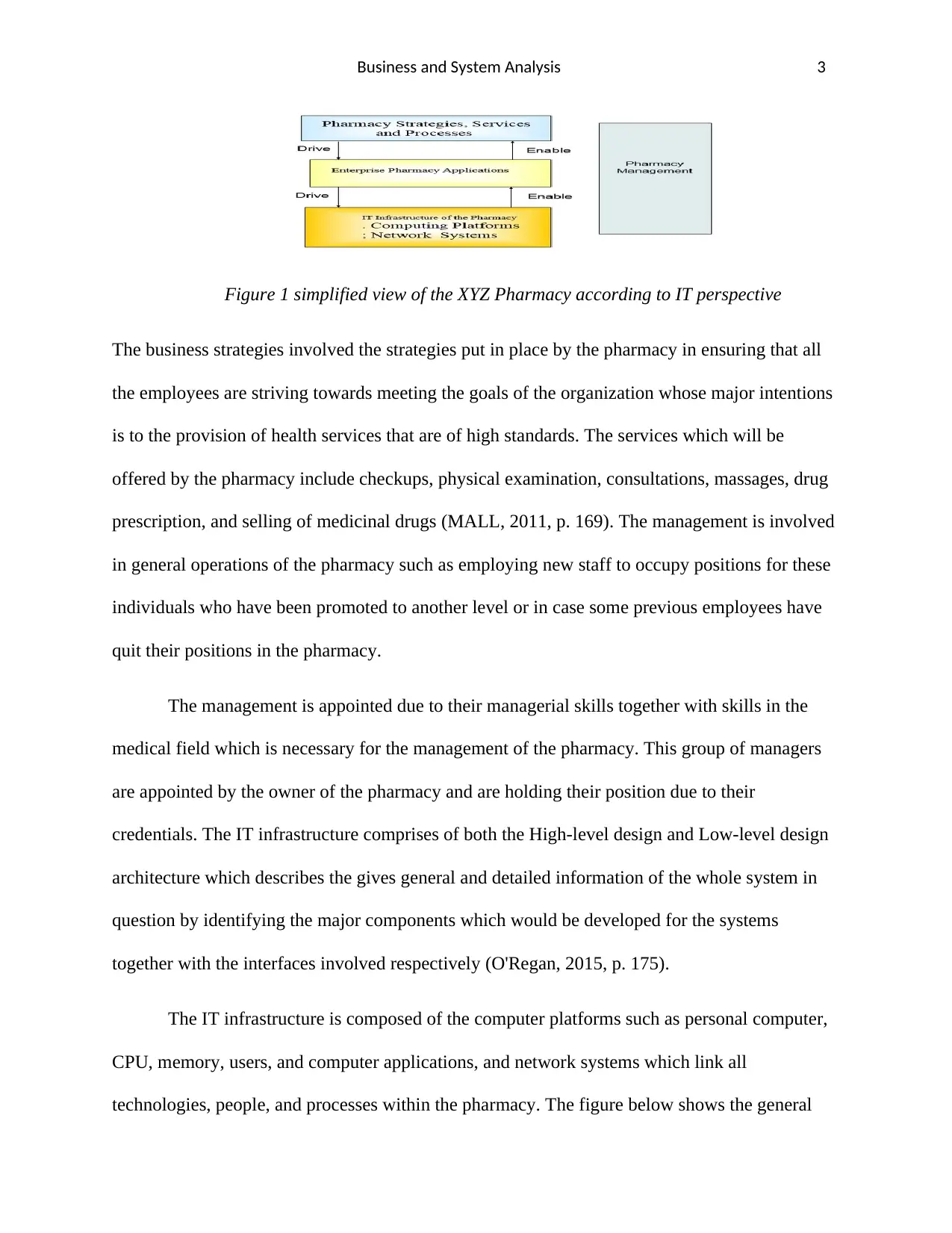
Business and System Analysis 3
Figure 1 simplified view of the XYZ Pharmacy according to IT perspective
The business strategies involved the strategies put in place by the pharmacy in ensuring that all
the employees are striving towards meeting the goals of the organization whose major intentions
is to the provision of health services that are of high standards. The services which will be
offered by the pharmacy include checkups, physical examination, consultations, massages, drug
prescription, and selling of medicinal drugs (MALL, 2011, p. 169). The management is involved
in general operations of the pharmacy such as employing new staff to occupy positions for these
individuals who have been promoted to another level or in case some previous employees have
quit their positions in the pharmacy.
The management is appointed due to their managerial skills together with skills in the
medical field which is necessary for the management of the pharmacy. This group of managers
are appointed by the owner of the pharmacy and are holding their position due to their
credentials. The IT infrastructure comprises of both the High-level design and Low-level design
architecture which describes the gives general and detailed information of the whole system in
question by identifying the major components which would be developed for the systems
together with the interfaces involved respectively (O'Regan, 2015, p. 175).
The IT infrastructure is composed of the computer platforms such as personal computer,
CPU, memory, users, and computer applications, and network systems which link all
technologies, people, and processes within the pharmacy. The figure below shows the general
Figure 1 simplified view of the XYZ Pharmacy according to IT perspective
The business strategies involved the strategies put in place by the pharmacy in ensuring that all
the employees are striving towards meeting the goals of the organization whose major intentions
is to the provision of health services that are of high standards. The services which will be
offered by the pharmacy include checkups, physical examination, consultations, massages, drug
prescription, and selling of medicinal drugs (MALL, 2011, p. 169). The management is involved
in general operations of the pharmacy such as employing new staff to occupy positions for these
individuals who have been promoted to another level or in case some previous employees have
quit their positions in the pharmacy.
The management is appointed due to their managerial skills together with skills in the
medical field which is necessary for the management of the pharmacy. This group of managers
are appointed by the owner of the pharmacy and are holding their position due to their
credentials. The IT infrastructure comprises of both the High-level design and Low-level design
architecture which describes the gives general and detailed information of the whole system in
question by identifying the major components which would be developed for the systems
together with the interfaces involved respectively (O'Regan, 2015, p. 175).
The IT infrastructure is composed of the computer platforms such as personal computer,
CPU, memory, users, and computer applications, and network systems which link all
technologies, people, and processes within the pharmacy. The figure below shows the general
⊘ This is a preview!⊘
Do you want full access?
Subscribe today to unlock all pages.

Trusted by 1+ million students worldwide
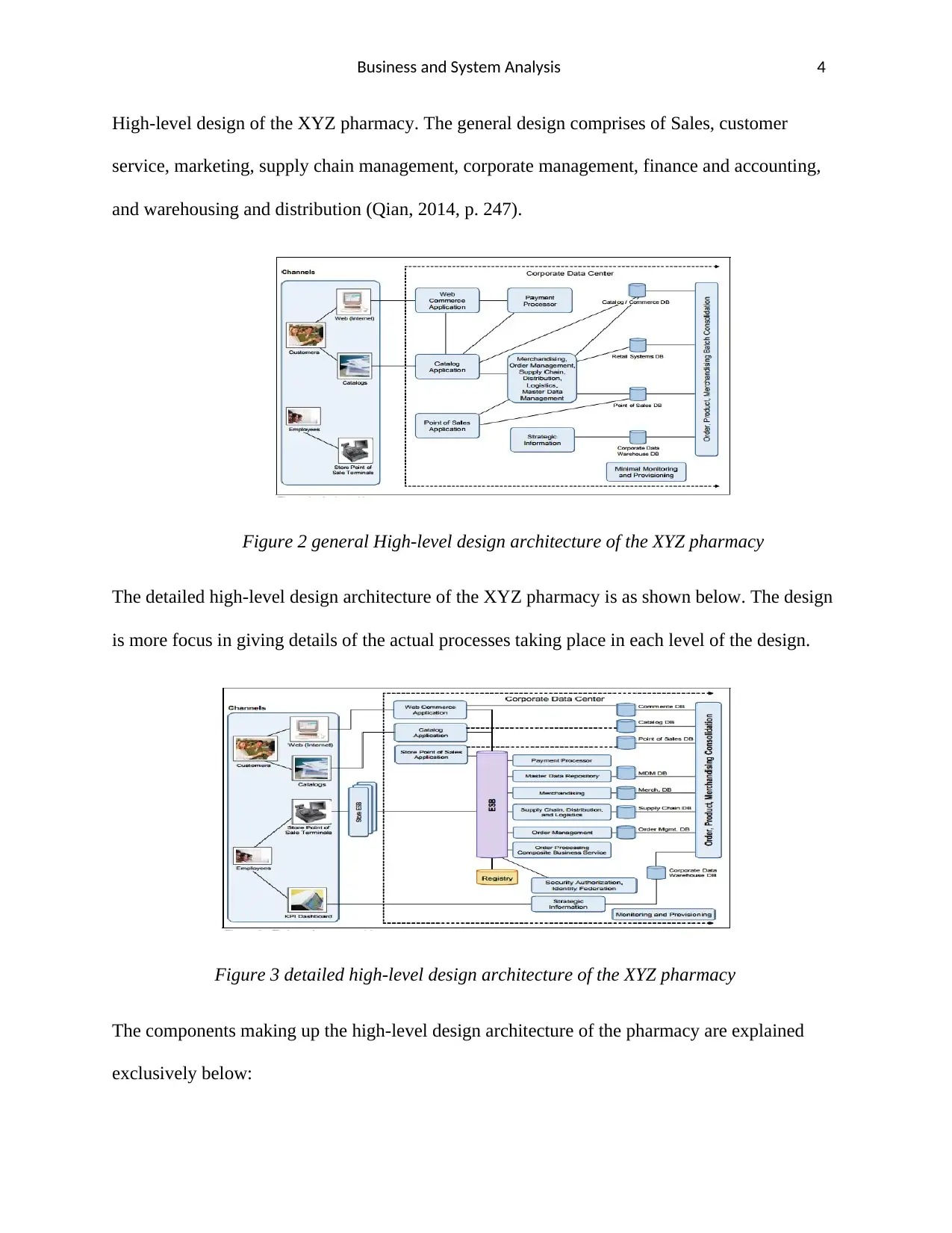
Business and System Analysis 4
High-level design of the XYZ pharmacy. The general design comprises of Sales, customer
service, marketing, supply chain management, corporate management, finance and accounting,
and warehousing and distribution (Qian, 2014, p. 247).
Figure 2 general High-level design architecture of the XYZ pharmacy
The detailed high-level design architecture of the XYZ pharmacy is as shown below. The design
is more focus in giving details of the actual processes taking place in each level of the design.
Figure 3 detailed high-level design architecture of the XYZ pharmacy
The components making up the high-level design architecture of the pharmacy are explained
exclusively below:
High-level design of the XYZ pharmacy. The general design comprises of Sales, customer
service, marketing, supply chain management, corporate management, finance and accounting,
and warehousing and distribution (Qian, 2014, p. 247).
Figure 2 general High-level design architecture of the XYZ pharmacy
The detailed high-level design architecture of the XYZ pharmacy is as shown below. The design
is more focus in giving details of the actual processes taking place in each level of the design.
Figure 3 detailed high-level design architecture of the XYZ pharmacy
The components making up the high-level design architecture of the pharmacy are explained
exclusively below:
Paraphrase This Document
Need a fresh take? Get an instant paraphrase of this document with our AI Paraphraser
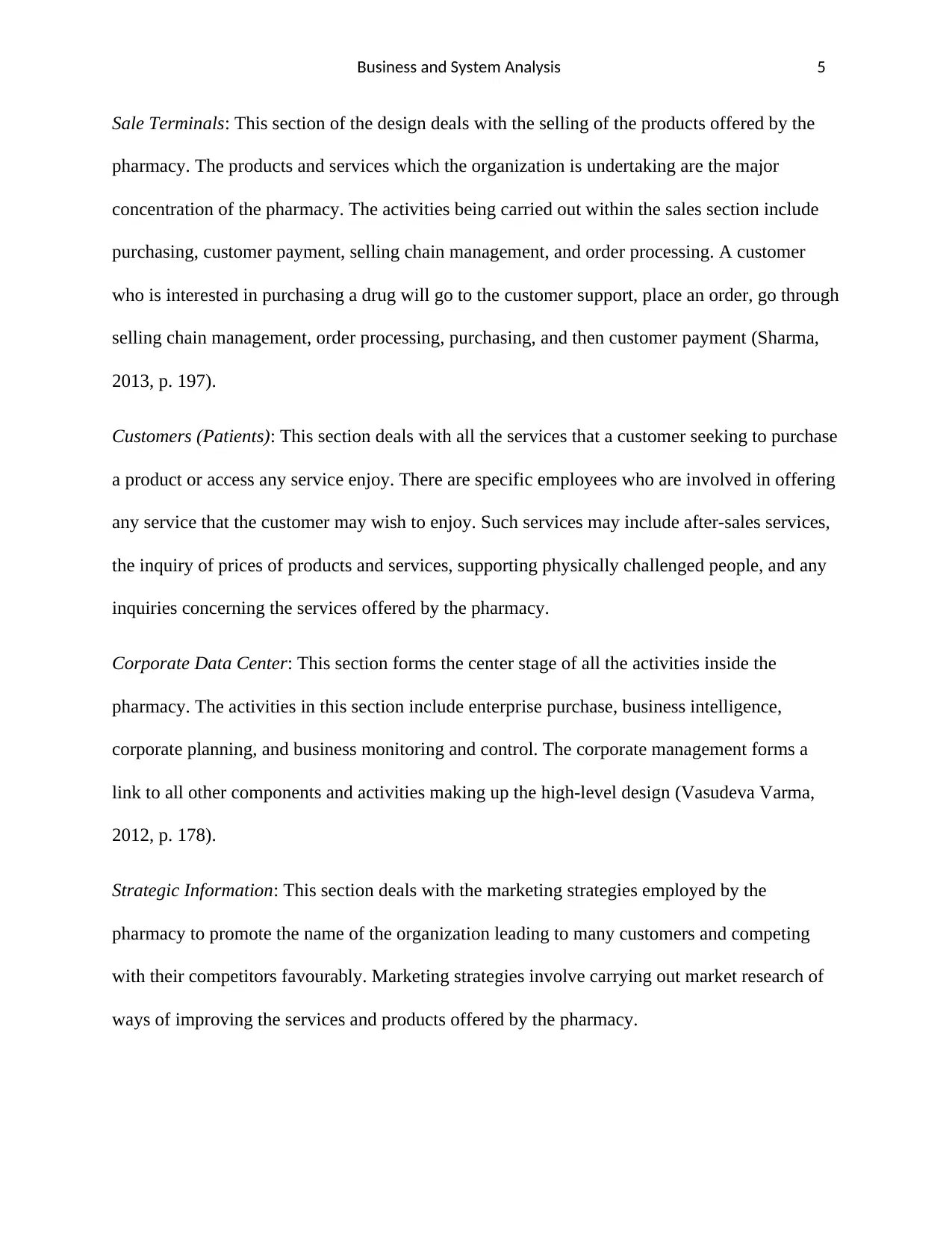
Business and System Analysis 5
Sale Terminals: This section of the design deals with the selling of the products offered by the
pharmacy. The products and services which the organization is undertaking are the major
concentration of the pharmacy. The activities being carried out within the sales section include
purchasing, customer payment, selling chain management, and order processing. A customer
who is interested in purchasing a drug will go to the customer support, place an order, go through
selling chain management, order processing, purchasing, and then customer payment (Sharma,
2013, p. 197).
Customers (Patients): This section deals with all the services that a customer seeking to purchase
a product or access any service enjoy. There are specific employees who are involved in offering
any service that the customer may wish to enjoy. Such services may include after-sales services,
the inquiry of prices of products and services, supporting physically challenged people, and any
inquiries concerning the services offered by the pharmacy.
Corporate Data Center: This section forms the center stage of all the activities inside the
pharmacy. The activities in this section include enterprise purchase, business intelligence,
corporate planning, and business monitoring and control. The corporate management forms a
link to all other components and activities making up the high-level design (Vasudeva Varma,
2012, p. 178).
Strategic Information: This section deals with the marketing strategies employed by the
pharmacy to promote the name of the organization leading to many customers and competing
with their competitors favourably. Marketing strategies involve carrying out market research of
ways of improving the services and products offered by the pharmacy.
Sale Terminals: This section of the design deals with the selling of the products offered by the
pharmacy. The products and services which the organization is undertaking are the major
concentration of the pharmacy. The activities being carried out within the sales section include
purchasing, customer payment, selling chain management, and order processing. A customer
who is interested in purchasing a drug will go to the customer support, place an order, go through
selling chain management, order processing, purchasing, and then customer payment (Sharma,
2013, p. 197).
Customers (Patients): This section deals with all the services that a customer seeking to purchase
a product or access any service enjoy. There are specific employees who are involved in offering
any service that the customer may wish to enjoy. Such services may include after-sales services,
the inquiry of prices of products and services, supporting physically challenged people, and any
inquiries concerning the services offered by the pharmacy.
Corporate Data Center: This section forms the center stage of all the activities inside the
pharmacy. The activities in this section include enterprise purchase, business intelligence,
corporate planning, and business monitoring and control. The corporate management forms a
link to all other components and activities making up the high-level design (Vasudeva Varma,
2012, p. 178).
Strategic Information: This section deals with the marketing strategies employed by the
pharmacy to promote the name of the organization leading to many customers and competing
with their competitors favourably. Marketing strategies involve carrying out market research of
ways of improving the services and products offered by the pharmacy.
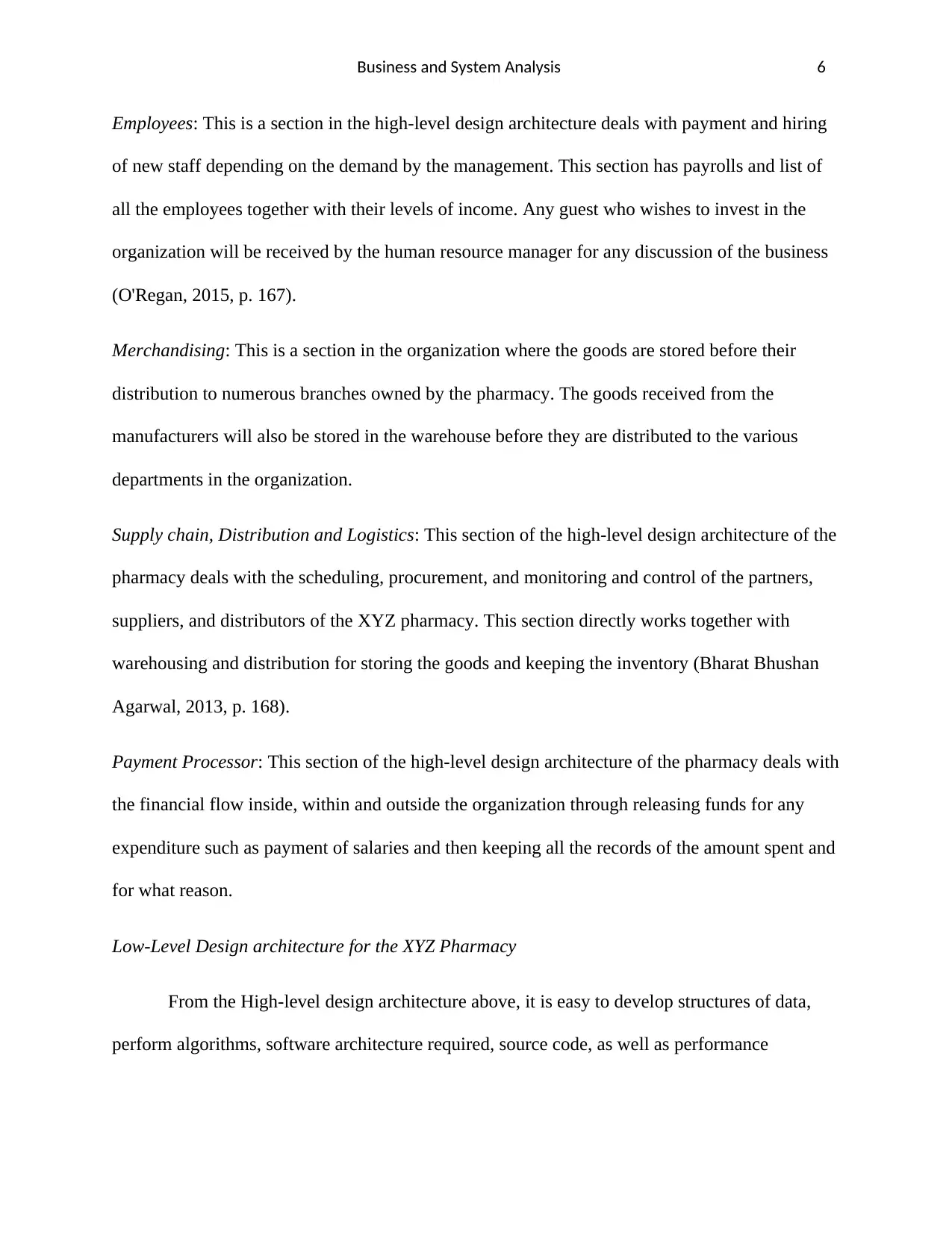
Business and System Analysis 6
Employees: This is a section in the high-level design architecture deals with payment and hiring
of new staff depending on the demand by the management. This section has payrolls and list of
all the employees together with their levels of income. Any guest who wishes to invest in the
organization will be received by the human resource manager for any discussion of the business
(O'Regan, 2015, p. 167).
Merchandising: This is a section in the organization where the goods are stored before their
distribution to numerous branches owned by the pharmacy. The goods received from the
manufacturers will also be stored in the warehouse before they are distributed to the various
departments in the organization.
Supply chain, Distribution and Logistics: This section of the high-level design architecture of the
pharmacy deals with the scheduling, procurement, and monitoring and control of the partners,
suppliers, and distributors of the XYZ pharmacy. This section directly works together with
warehousing and distribution for storing the goods and keeping the inventory (Bharat Bhushan
Agarwal, 2013, p. 168).
Payment Processor: This section of the high-level design architecture of the pharmacy deals with
the financial flow inside, within and outside the organization through releasing funds for any
expenditure such as payment of salaries and then keeping all the records of the amount spent and
for what reason.
Low-Level Design architecture for the XYZ Pharmacy
From the High-level design architecture above, it is easy to develop structures of data,
perform algorithms, software architecture required, source code, as well as performance
Employees: This is a section in the high-level design architecture deals with payment and hiring
of new staff depending on the demand by the management. This section has payrolls and list of
all the employees together with their levels of income. Any guest who wishes to invest in the
organization will be received by the human resource manager for any discussion of the business
(O'Regan, 2015, p. 167).
Merchandising: This is a section in the organization where the goods are stored before their
distribution to numerous branches owned by the pharmacy. The goods received from the
manufacturers will also be stored in the warehouse before they are distributed to the various
departments in the organization.
Supply chain, Distribution and Logistics: This section of the high-level design architecture of the
pharmacy deals with the scheduling, procurement, and monitoring and control of the partners,
suppliers, and distributors of the XYZ pharmacy. This section directly works together with
warehousing and distribution for storing the goods and keeping the inventory (Bharat Bhushan
Agarwal, 2013, p. 168).
Payment Processor: This section of the high-level design architecture of the pharmacy deals with
the financial flow inside, within and outside the organization through releasing funds for any
expenditure such as payment of salaries and then keeping all the records of the amount spent and
for what reason.
Low-Level Design architecture for the XYZ Pharmacy
From the High-level design architecture above, it is easy to develop structures of data,
perform algorithms, software architecture required, source code, as well as performance
⊘ This is a preview!⊘
Do you want full access?
Subscribe today to unlock all pages.

Trusted by 1+ million students worldwide
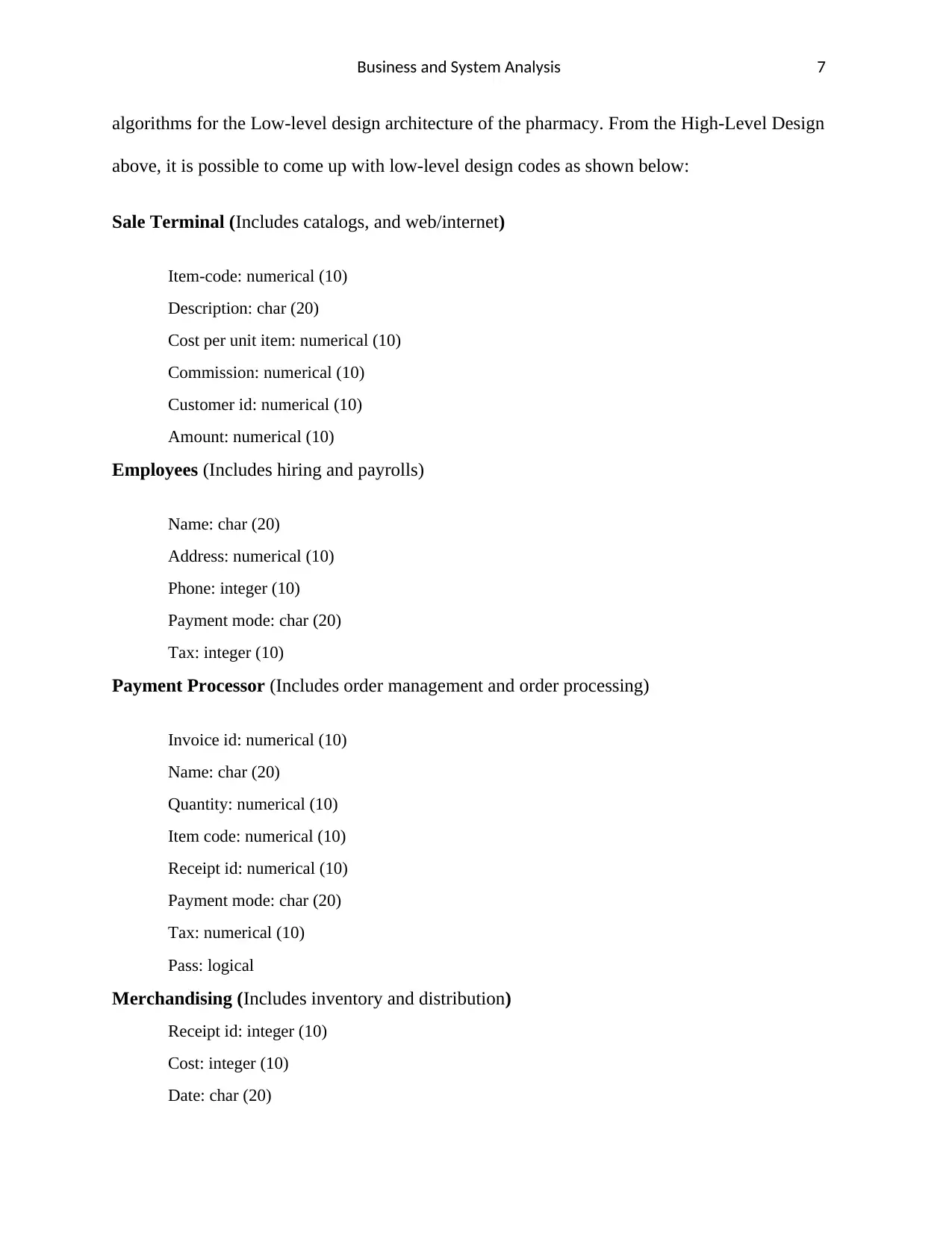
Business and System Analysis 7
algorithms for the Low-level design architecture of the pharmacy. From the High-Level Design
above, it is possible to come up with low-level design codes as shown below:
Sale Terminal (Includes catalogs, and web/internet)
Item-code: numerical (10)
Description: char (20)
Cost per unit item: numerical (10)
Commission: numerical (10)
Customer id: numerical (10)
Amount: numerical (10)
Employees (Includes hiring and payrolls)
Name: char (20)
Address: numerical (10)
Phone: integer (10)
Payment mode: char (20)
Tax: integer (10)
Payment Processor (Includes order management and order processing)
Invoice id: numerical (10)
Name: char (20)
Quantity: numerical (10)
Item code: numerical (10)
Receipt id: numerical (10)
Payment mode: char (20)
Tax: numerical (10)
Pass: logical
Merchandising (Includes inventory and distribution)
Receipt id: integer (10)
Cost: integer (10)
Date: char (20)
algorithms for the Low-level design architecture of the pharmacy. From the High-Level Design
above, it is possible to come up with low-level design codes as shown below:
Sale Terminal (Includes catalogs, and web/internet)
Item-code: numerical (10)
Description: char (20)
Cost per unit item: numerical (10)
Commission: numerical (10)
Customer id: numerical (10)
Amount: numerical (10)
Employees (Includes hiring and payrolls)
Name: char (20)
Address: numerical (10)
Phone: integer (10)
Payment mode: char (20)
Tax: integer (10)
Payment Processor (Includes order management and order processing)
Invoice id: numerical (10)
Name: char (20)
Quantity: numerical (10)
Item code: numerical (10)
Receipt id: numerical (10)
Payment mode: char (20)
Tax: numerical (10)
Pass: logical
Merchandising (Includes inventory and distribution)
Receipt id: integer (10)
Cost: integer (10)
Date: char (20)
Paraphrase This Document
Need a fresh take? Get an instant paraphrase of this document with our AI Paraphraser
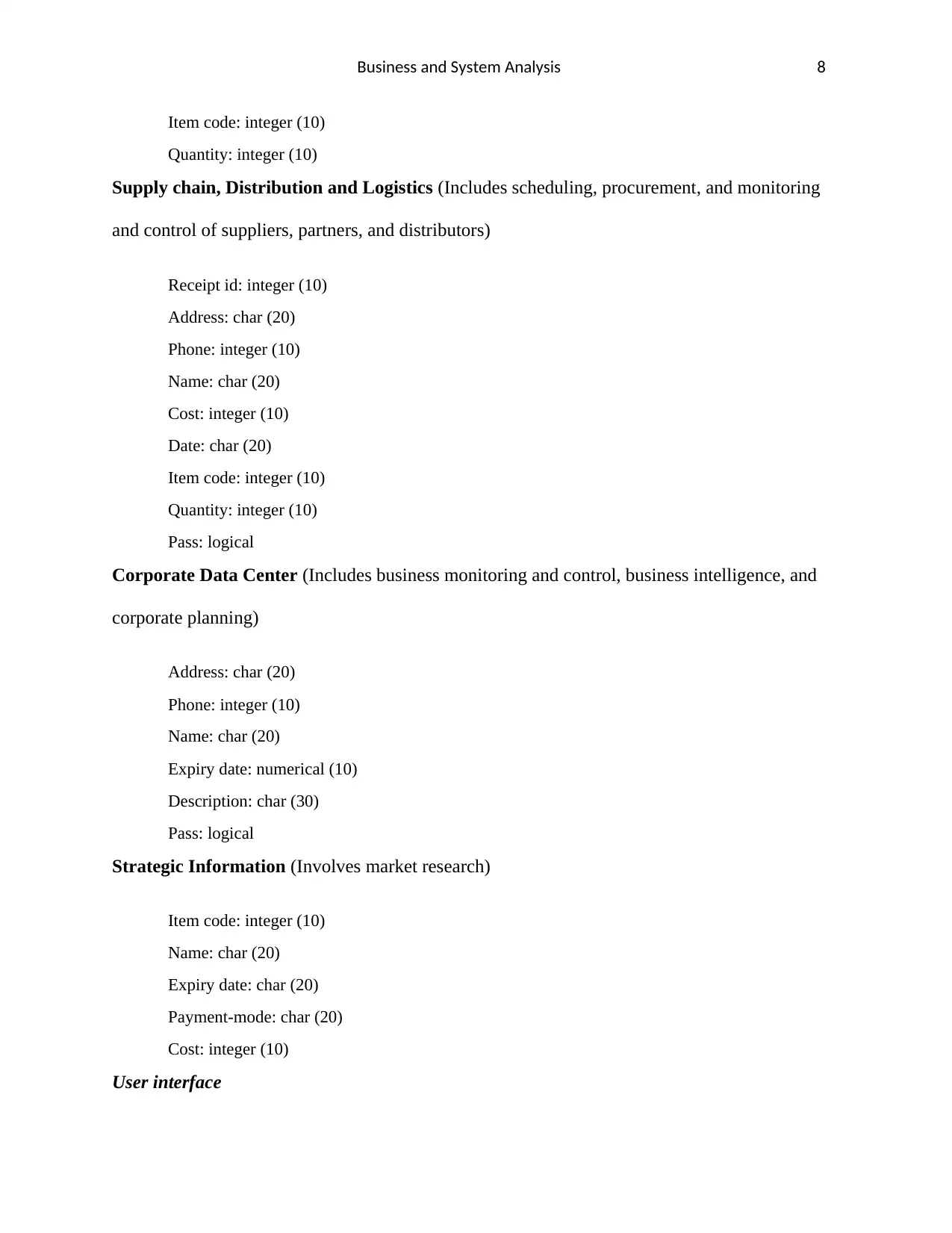
Business and System Analysis 8
Item code: integer (10)
Quantity: integer (10)
Supply chain, Distribution and Logistics (Includes scheduling, procurement, and monitoring
and control of suppliers, partners, and distributors)
Receipt id: integer (10)
Address: char (20)
Phone: integer (10)
Name: char (20)
Cost: integer (10)
Date: char (20)
Item code: integer (10)
Quantity: integer (10)
Pass: logical
Corporate Data Center (Includes business monitoring and control, business intelligence, and
corporate planning)
Address: char (20)
Phone: integer (10)
Name: char (20)
Expiry date: numerical (10)
Description: char (30)
Pass: logical
Strategic Information (Involves market research)
Item code: integer (10)
Name: char (20)
Expiry date: char (20)
Payment-mode: char (20)
Cost: integer (10)
User interface
Item code: integer (10)
Quantity: integer (10)
Supply chain, Distribution and Logistics (Includes scheduling, procurement, and monitoring
and control of suppliers, partners, and distributors)
Receipt id: integer (10)
Address: char (20)
Phone: integer (10)
Name: char (20)
Cost: integer (10)
Date: char (20)
Item code: integer (10)
Quantity: integer (10)
Pass: logical
Corporate Data Center (Includes business monitoring and control, business intelligence, and
corporate planning)
Address: char (20)
Phone: integer (10)
Name: char (20)
Expiry date: numerical (10)
Description: char (30)
Pass: logical
Strategic Information (Involves market research)
Item code: integer (10)
Name: char (20)
Expiry date: char (20)
Payment-mode: char (20)
Cost: integer (10)
User interface
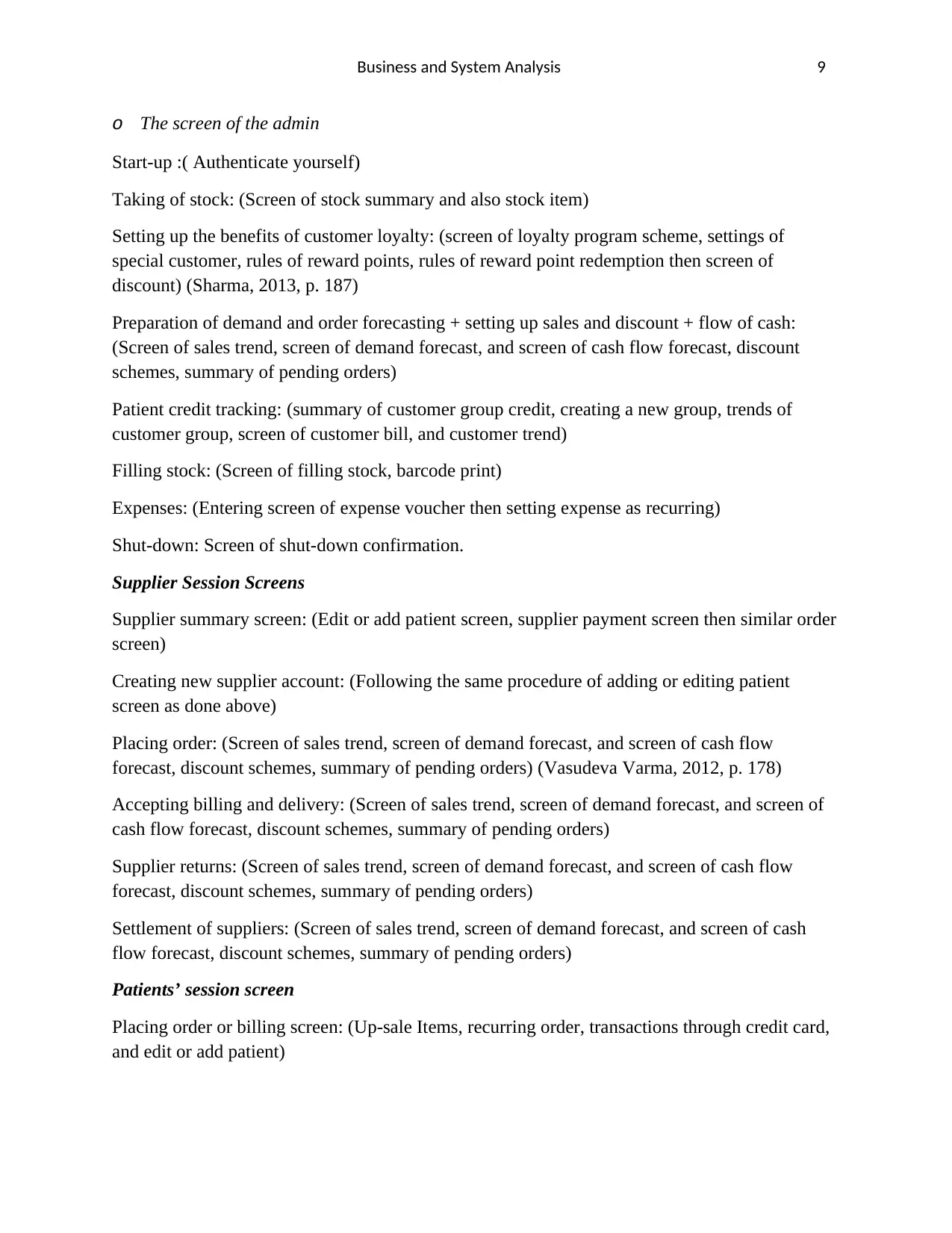
Business and System Analysis 9
o The screen of the admin
Start-up :( Authenticate yourself)
Taking of stock: (Screen of stock summary and also stock item)
Setting up the benefits of customer loyalty: (screen of loyalty program scheme, settings of
special customer, rules of reward points, rules of reward point redemption then screen of
discount) (Sharma, 2013, p. 187)
Preparation of demand and order forecasting + setting up sales and discount + flow of cash:
(Screen of sales trend, screen of demand forecast, and screen of cash flow forecast, discount
schemes, summary of pending orders)
Patient credit tracking: (summary of customer group credit, creating a new group, trends of
customer group, screen of customer bill, and customer trend)
Filling stock: (Screen of filling stock, barcode print)
Expenses: (Entering screen of expense voucher then setting expense as recurring)
Shut-down: Screen of shut-down confirmation.
Supplier Session Screens
Supplier summary screen: (Edit or add patient screen, supplier payment screen then similar order
screen)
Creating new supplier account: (Following the same procedure of adding or editing patient
screen as done above)
Placing order: (Screen of sales trend, screen of demand forecast, and screen of cash flow
forecast, discount schemes, summary of pending orders) (Vasudeva Varma, 2012, p. 178)
Accepting billing and delivery: (Screen of sales trend, screen of demand forecast, and screen of
cash flow forecast, discount schemes, summary of pending orders)
Supplier returns: (Screen of sales trend, screen of demand forecast, and screen of cash flow
forecast, discount schemes, summary of pending orders)
Settlement of suppliers: (Screen of sales trend, screen of demand forecast, and screen of cash
flow forecast, discount schemes, summary of pending orders)
Patients’ session screen
Placing order or billing screen: (Up-sale Items, recurring order, transactions through credit card,
and edit or add patient)
o The screen of the admin
Start-up :( Authenticate yourself)
Taking of stock: (Screen of stock summary and also stock item)
Setting up the benefits of customer loyalty: (screen of loyalty program scheme, settings of
special customer, rules of reward points, rules of reward point redemption then screen of
discount) (Sharma, 2013, p. 187)
Preparation of demand and order forecasting + setting up sales and discount + flow of cash:
(Screen of sales trend, screen of demand forecast, and screen of cash flow forecast, discount
schemes, summary of pending orders)
Patient credit tracking: (summary of customer group credit, creating a new group, trends of
customer group, screen of customer bill, and customer trend)
Filling stock: (Screen of filling stock, barcode print)
Expenses: (Entering screen of expense voucher then setting expense as recurring)
Shut-down: Screen of shut-down confirmation.
Supplier Session Screens
Supplier summary screen: (Edit or add patient screen, supplier payment screen then similar order
screen)
Creating new supplier account: (Following the same procedure of adding or editing patient
screen as done above)
Placing order: (Screen of sales trend, screen of demand forecast, and screen of cash flow
forecast, discount schemes, summary of pending orders) (Vasudeva Varma, 2012, p. 178)
Accepting billing and delivery: (Screen of sales trend, screen of demand forecast, and screen of
cash flow forecast, discount schemes, summary of pending orders)
Supplier returns: (Screen of sales trend, screen of demand forecast, and screen of cash flow
forecast, discount schemes, summary of pending orders)
Settlement of suppliers: (Screen of sales trend, screen of demand forecast, and screen of cash
flow forecast, discount schemes, summary of pending orders)
Patients’ session screen
Placing order or billing screen: (Up-sale Items, recurring order, transactions through credit card,
and edit or add patient)
⊘ This is a preview!⊘
Do you want full access?
Subscribe today to unlock all pages.

Trusted by 1+ million students worldwide
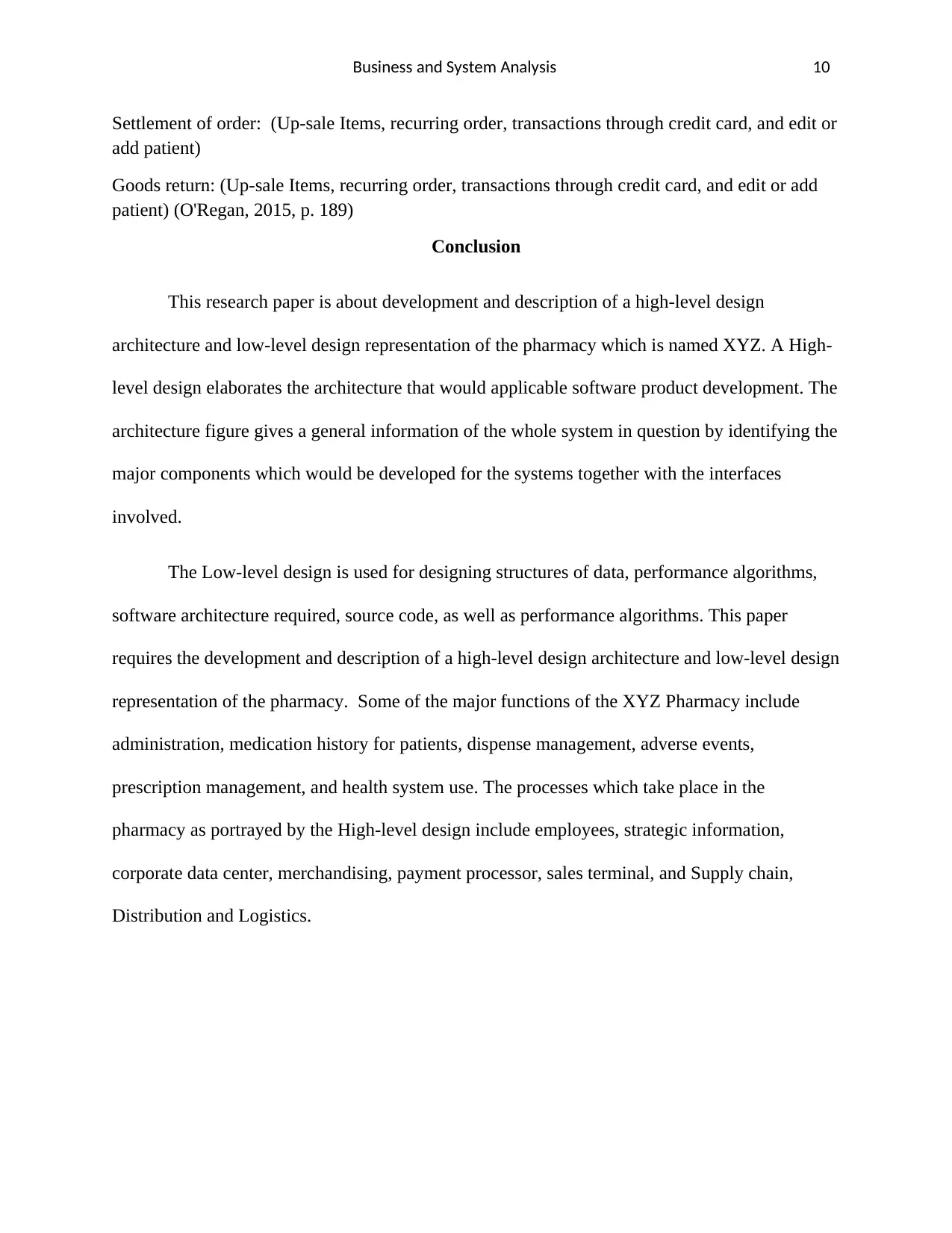
Business and System Analysis 10
Settlement of order: (Up-sale Items, recurring order, transactions through credit card, and edit or
add patient)
Goods return: (Up-sale Items, recurring order, transactions through credit card, and edit or add
patient) (O'Regan, 2015, p. 189)
Conclusion
This research paper is about development and description of a high-level design
architecture and low-level design representation of the pharmacy which is named XYZ. A High-
level design elaborates the architecture that would applicable software product development. The
architecture figure gives a general information of the whole system in question by identifying the
major components which would be developed for the systems together with the interfaces
involved.
The Low-level design is used for designing structures of data, performance algorithms,
software architecture required, source code, as well as performance algorithms. This paper
requires the development and description of a high-level design architecture and low-level design
representation of the pharmacy. Some of the major functions of the XYZ Pharmacy include
administration, medication history for patients, dispense management, adverse events,
prescription management, and health system use. The processes which take place in the
pharmacy as portrayed by the High-level design include employees, strategic information,
corporate data center, merchandising, payment processor, sales terminal, and Supply chain,
Distribution and Logistics.
Settlement of order: (Up-sale Items, recurring order, transactions through credit card, and edit or
add patient)
Goods return: (Up-sale Items, recurring order, transactions through credit card, and edit or add
patient) (O'Regan, 2015, p. 189)
Conclusion
This research paper is about development and description of a high-level design
architecture and low-level design representation of the pharmacy which is named XYZ. A High-
level design elaborates the architecture that would applicable software product development. The
architecture figure gives a general information of the whole system in question by identifying the
major components which would be developed for the systems together with the interfaces
involved.
The Low-level design is used for designing structures of data, performance algorithms,
software architecture required, source code, as well as performance algorithms. This paper
requires the development and description of a high-level design architecture and low-level design
representation of the pharmacy. Some of the major functions of the XYZ Pharmacy include
administration, medication history for patients, dispense management, adverse events,
prescription management, and health system use. The processes which take place in the
pharmacy as portrayed by the High-level design include employees, strategic information,
corporate data center, merchandising, payment processor, sales terminal, and Supply chain,
Distribution and Logistics.
Paraphrase This Document
Need a fresh take? Get an instant paraphrase of this document with our AI Paraphraser
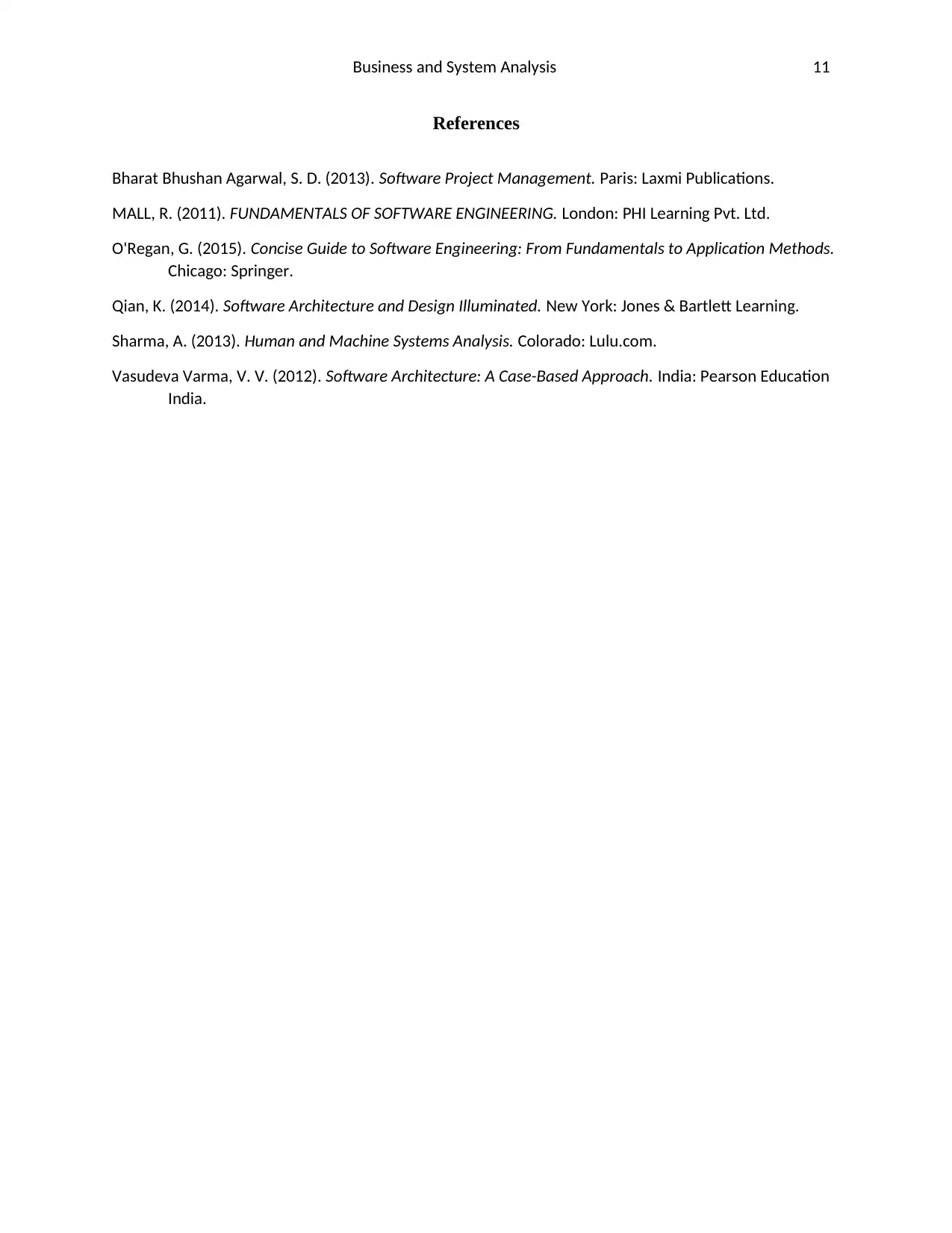
Business and System Analysis 11
References
Bharat Bhushan Agarwal, S. D. (2013). Software Project Management. Paris: Laxmi Publications.
MALL, R. (2011). FUNDAMENTALS OF SOFTWARE ENGINEERING. London: PHI Learning Pvt. Ltd.
O'Regan, G. (2015). Concise Guide to Software Engineering: From Fundamentals to Application Methods.
Chicago: Springer.
Qian, K. (2014). Software Architecture and Design Illuminated. New York: Jones & Bartlett Learning.
Sharma, A. (2013). Human and Machine Systems Analysis. Colorado: Lulu.com.
Vasudeva Varma, V. V. (2012). Software Architecture: A Case-Based Approach. India: Pearson Education
India.
References
Bharat Bhushan Agarwal, S. D. (2013). Software Project Management. Paris: Laxmi Publications.
MALL, R. (2011). FUNDAMENTALS OF SOFTWARE ENGINEERING. London: PHI Learning Pvt. Ltd.
O'Regan, G. (2015). Concise Guide to Software Engineering: From Fundamentals to Application Methods.
Chicago: Springer.
Qian, K. (2014). Software Architecture and Design Illuminated. New York: Jones & Bartlett Learning.
Sharma, A. (2013). Human and Machine Systems Analysis. Colorado: Lulu.com.
Vasudeva Varma, V. V. (2012). Software Architecture: A Case-Based Approach. India: Pearson Education
India.
1 out of 11
Related Documents
Your All-in-One AI-Powered Toolkit for Academic Success.
+13062052269
info@desklib.com
Available 24*7 on WhatsApp / Email
![[object Object]](/_next/static/media/star-bottom.7253800d.svg)
Unlock your academic potential
Copyright © 2020–2025 A2Z Services. All Rights Reserved. Developed and managed by ZUCOL.
![Family First Medical Center System Design Project - [University Name]](/_next/image/?url=https%3A%2F%2Fdesklib.com%2Fmedia%2Fimages%2Fxh%2Fdcf8af90d72942969f09f64d8ab63721.jpg&w=256&q=75)


